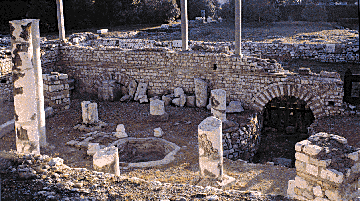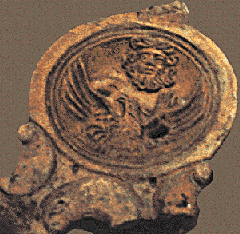Athena Review Vol.1, no.4
Sites and Museums in Roman Gaul: Nice-Cimiez
A Greek stronghold was founded on the Colline du Château at Nice in
the 4th century BC by Phocaeans from Marseille. Nice originally had the Greek
name Nikaia Polis, or the town of victory (from Nike, victory, and
Polis for city). The northern suburb of Cimiez where considerable Roman remains
are located was known as Cemenelum. Ancient sources include the Peutinger
Table and the Antonine Itinerary.
In the 3rd and 2nd centuries BC, Cemenelum was a base of the Vediantii, a
Ligurian tribe. In 154 BC Romans helped Massiliotes defend both Nikaia and
Antipolis (Antibes) from Ligurian attacks, after which Cemenelum became a
Roman settlement along the Via Julia, a major Roman road. Favorably located,
Cemenelum was chosen as the principal seat of the province of Alpes Maritimae
by Augustus in 14 BC. Later, the Romans settled further inland, on the opposite
side of the river Paillon. Remains of the town on the Hill of Cimiez date
to the 3rd century AD, and are now part of the archaeological park at
Nice-Cimiez.
 The
Amphitheater at the northern end of the site was originally built
of wood and seated only 500-600. It was later rebuilt in stone during the
Severan dynasty (AD 193-217) with its capacity expanded to 5000 persons.
The vaulted remains at Nice (fig.1) may be compared to other small
amphitheaters in garrison towns in the Roman Empire including Caerleon and
Caerwent in Wales, Carnuntum in Austria, and Emerita in Spain. Seating in
the amphitheater reflected class distinctions between officers and enlisted
men, with the structure at Nice-Cimiez divided into two sections reached
by separate entrances.
The
Amphitheater at the northern end of the site was originally built
of wood and seated only 500-600. It was later rebuilt in stone during the
Severan dynasty (AD 193-217) with its capacity expanded to 5000 persons.
The vaulted remains at Nice (fig.1) may be compared to other small
amphitheaters in garrison towns in the Roman Empire including Caerleon and
Caerwent in Wales, Carnuntum in Austria, and Emerita in Spain. Seating in
the amphitheater reflected class distinctions between officers and enlisted
men, with the structure at Nice-Cimiez divided into two sections reached
by separate entrances.
[Fig.1: Roman amphitheater at north end of Nice-Cimiez archaeological
park (photo: Athena Review).]
 The Roman
Bath Complex at Nice-Cimiez is the largest known in Gaul. First surveyed
by Duval in 1943, the baths were excavated over the next 30 years by F. Benoit.
During the Severan period the North or Magistrate's Bath (fig.2, left)
was built, then expanded to include separate East (men's) and West (women's)
bathing areas, the latter having large quantities of hair pins and earrings
recovered from the drains. Bath areas identified for visitors include the
cold bath (frigidarium), warm bath (tepidarium), sweat bath(laconicum), hot
bath (caldarium), swimming pool (natatio), and court and exercise ground
(palaestra).
The Roman
Bath Complex at Nice-Cimiez is the largest known in Gaul. First surveyed
by Duval in 1943, the baths were excavated over the next 30 years by F. Benoit.
During the Severan period the North or Magistrate's Bath (fig.2, left)
was built, then expanded to include separate East (men's) and West (women's)
bathing areas, the latter having large quantities of hair pins and earrings
recovered from the drains. Bath areas identified for visitors include the
cold bath (frigidarium), warm bath (tepidarium), sweat bath(laconicum), hot
bath (caldarium), swimming pool (natatio), and court and exercise ground
(palaestra).
[Fig.2: Frigidarium in Magistrate's Baths, Nice-Cimiez (photo:
Athena Review).]
An Early Christian Basilica was erected in the 4th century AD out
of remnants of the West or Women's Bath (fig.3). One room near the
site of the archaeological museum served as a baptistry. By the mid 5th century
AD, Cemenelum, like Nice, had its own bishop. Other Roman remains in the
archaeological park include sections of the town's major roads, including
the cardo and two identified decumani, and parts of a 1st
centur y AD boundary
wall possibly with an extension of the town aqueduct. The castellum or
distribution tank of the aqueduct was located at the site of the Musée
Matisse, featuring work of the major 20th century artist Henri Matisse.
y AD boundary
wall possibly with an extension of the town aqueduct. The castellum or
distribution tank of the aqueduct was located at the site of the Musée
Matisse, featuring work of the major 20th century artist Henri Matisse.
[Fig.3: Early 4th century AD Christian Basilica in Nice-Cimiez Baths
(photo: Athena Review.)
The Archaeological Museum, located at the west end of the Baths complex,
displays a wide variety of artifacts from both the Bath site and the region
of Nice-Cimiez.
Sculpture: Prominently featured is a1st century AD statue of Antonia
Minor, daughter of Mark Antony and mother of the Emperor Claudius. Fine bronzes
on display from the La Formigue "C" shipwreck (ca.80 BC) in the Golfe-Juan
near Antibes include a bronze mask of Silenus, and curved fulcrums or couch
fittings in the forms of a horse, donkey, and duck. Other bronze statuettes
include a Hellenistic dancing faun, several figurines of Hercules, and the
tiny, short-armed "Warrior of Mont Bego" from the Late Iron Age, shown among
finely incised bronze bracelets.
Inscriptions include Roman milestones from the Via Julia between Cimiez
and nearby Menton, on the French-Italian border. Also shown are an altar
dedicated by the magistrate Lucius Blasius Cornutus; an altar inscribed to
Jupiter, Best and Greatest (Jove O.M.); and a well-carved symbolic altar
to Mercury with caduceus and rooster in relief, plus another inscription
to the same god found in 1966. Funerary monuments with inscribed texts
include tombstones and several sarcophagi, with a fine example of a
paleo-Christian sarcophagus of the 3rd century AD.
 Artifacts and
technology: Several examples of 5th-4th century BC Greek kraters are
painted with mythological scenes. Nearby is a selection of amphorae with
a chart outlining their typology. Household items include earthenware pots,
bowls, cups and pitchers, and pottery lamps, with a double-beaked lamp showing
the image of Jupiter and an eagle (fig.4). Terra sigillata, the fine
paste, mold-decorated redware manufactured in Gaul during the 1st century
AD, is also abundantly displayed. Glasswork includes Roman vials and other
vessels, and decorated glass with horse designs and inscriptions. Ancient
metalwork with a surprisingly familiar look is represented by an iron balance
for hanging scales, hand tools (ie., chisels and knives), and an assortment
of iron keys and lock parts, commonly found in ancient Roman towns.
Artifacts and
technology: Several examples of 5th-4th century BC Greek kraters are
painted with mythological scenes. Nearby is a selection of amphorae with
a chart outlining their typology. Household items include earthenware pots,
bowls, cups and pitchers, and pottery lamps, with a double-beaked lamp showing
the image of Jupiter and an eagle (fig.4). Terra sigillata, the fine
paste, mold-decorated redware manufactured in Gaul during the 1st century
AD, is also abundantly displayed. Glasswork includes Roman vials and other
vessels, and decorated glass with horse designs and inscriptions. Ancient
metalwork with a surprisingly familiar look is represented by an iron balance
for hanging scales, hand tools (ie., chisels and knives), and an assortment
of iron keys and lock parts, commonly found in ancient Roman towns.
.
[Fig.4: Gallo-Roman terracotta lamp of Jupiter and Eagle (Musée
Arquéologique de Nice-Cimiez; photo: Athena Review).]
Athena Review Image
Archive™ |
Paleoanthropology in
the News
| Guide
to Archaeology on the Internet |
Free issue
|
Back issues
Main index of Athena
Review |
Subject Index
| Travel
Pages |
Galleries and
Museums |
Ad
rates |
Current issue
index |
Copyright © 1996-2001 Athena
Publications, Inc. (All Rights Reserved).
 The
Amphitheater at the northern end of the site was originally built
of wood and seated only 500-600. It was later rebuilt in stone during the
Severan dynasty (AD 193-217) with its capacity expanded to 5000 persons.
The vaulted remains at Nice (fig.1) may be compared to other small
amphitheaters in garrison towns in the Roman Empire including Caerleon and
Caerwent in Wales, Carnuntum in Austria, and Emerita in Spain. Seating in
the amphitheater reflected class distinctions between officers and enlisted
men, with the structure at Nice-Cimiez divided into two sections reached
by separate entrances.
The
Amphitheater at the northern end of the site was originally built
of wood and seated only 500-600. It was later rebuilt in stone during the
Severan dynasty (AD 193-217) with its capacity expanded to 5000 persons.
The vaulted remains at Nice (fig.1) may be compared to other small
amphitheaters in garrison towns in the Roman Empire including Caerleon and
Caerwent in Wales, Carnuntum in Austria, and Emerita in Spain. Seating in
the amphitheater reflected class distinctions between officers and enlisted
men, with the structure at Nice-Cimiez divided into two sections reached
by separate entrances.
 The Roman
Bath Complex at Nice-Cimiez is the largest known in Gaul. First surveyed
by Duval in 1943, the baths were excavated over the next 30 years by F. Benoit.
During the Severan period the North or Magistrate's Bath (fig.2, left)
was built, then expanded to include separate East (men's) and West (women's)
bathing areas, the latter having large quantities of hair pins and earrings
recovered from the drains. Bath areas identified for visitors include the
cold bath (frigidarium), warm bath (tepidarium), sweat bath(laconicum), hot
bath (caldarium), swimming pool (natatio), and court and exercise ground
(palaestra).
The Roman
Bath Complex at Nice-Cimiez is the largest known in Gaul. First surveyed
by Duval in 1943, the baths were excavated over the next 30 years by F. Benoit.
During the Severan period the North or Magistrate's Bath (fig.2, left)
was built, then expanded to include separate East (men's) and West (women's)
bathing areas, the latter having large quantities of hair pins and earrings
recovered from the drains. Bath areas identified for visitors include the
cold bath (frigidarium), warm bath (tepidarium), sweat bath(laconicum), hot
bath (caldarium), swimming pool (natatio), and court and exercise ground
(palaestra).
 y AD boundary
wall possibly with an extension of the town aqueduct. The castellum or
distribution tank of the aqueduct was located at the site of the Musée
Matisse, featuring work of the major 20th century artist Henri Matisse.
y AD boundary
wall possibly with an extension of the town aqueduct. The castellum or
distribution tank of the aqueduct was located at the site of the Musée
Matisse, featuring work of the major 20th century artist Henri Matisse.
 Artifacts and
technology: Several examples of 5th-4th century BC Greek kraters are
painted with mythological scenes. Nearby is a selection of amphorae with
a chart outlining their typology. Household items include earthenware pots,
bowls, cups and pitchers, and pottery lamps, with a double-beaked lamp showing
the image of Jupiter and an eagle (fig.4). Terra sigillata, the fine
paste, mold-decorated redware manufactured in Gaul during the 1st century
AD, is also abundantly displayed. Glasswork includes Roman vials and other
vessels, and decorated glass with horse designs and inscriptions. Ancient
metalwork with a surprisingly familiar look is represented by an iron balance
for hanging scales, hand tools (ie., chisels and knives), and an assortment
of iron keys and lock parts, commonly found in ancient Roman towns.
Artifacts and
technology: Several examples of 5th-4th century BC Greek kraters are
painted with mythological scenes. Nearby is a selection of amphorae with
a chart outlining their typology. Household items include earthenware pots,
bowls, cups and pitchers, and pottery lamps, with a double-beaked lamp showing
the image of Jupiter and an eagle (fig.4). Terra sigillata, the fine
paste, mold-decorated redware manufactured in Gaul during the 1st century
AD, is also abundantly displayed. Glasswork includes Roman vials and other
vessels, and decorated glass with horse designs and inscriptions. Ancient
metalwork with a surprisingly familiar look is represented by an iron balance
for hanging scales, hand tools (ie., chisels and knives), and an assortment
of iron keys and lock parts, commonly found in ancient Roman towns.